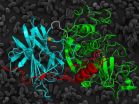(Press-News.org) MAYWOOD, Ill -- A leukemia drug called dasatinib shows promise for treating skin, breast and several other cancers, according to researchers at Loyola University Chicago Stritch School of Medicine.
Dasatinib fights leukemia by checking the uncontrolled growth of cancer cells. But when used against other cancer cells, researchers found, the drug employs a different strategy: It causes the cells to clump together, thus preventing them from migrating. Without the ability to migrate, cancer cells cannot metastasize (spread to other parts of the body).
Mitchell Denning, PhD, and colleagues discovered the molecular mechanism behind this cell-cell adhesion. The researchers reported their findings in a study published online ahead of print in the journal Molecular Carcinogenesis.
Dasatinib (trade name, Sprycel) is approved for certain types of leukemia. It targets a protein called BCR-ABL that fuels the growth of cancer cells.
BCR-ABL is similar to a protein called Fyn that's found in other malignancies, including breast, brain, pancreatic, skin and head-and-neck cancers. Fyn is associated with cell-cell adhesion and cell migration.
Denning and colleagues found that applying dasatinib to cancer cells in the laboratory caused the cells to clump together, and also prevented the cells from migrating. They found similar results with breast cancer cells. While dasatinib did not eliminate Fyn, it inhibited the protein's activity.
The researchers also found that dasatinib reduced the number and size of tumors in mice that had skin cancer.
Denning noted that clinical trials are underway to test dasatinib on patients with melanoma, prostate cancer, pancreatic cancer, endometrial cancer, gastrointestinal stromal cancer, ovarian cancer, multiple myeloma, Hodgkin's lymphoma and acute lymphoblastic leukemia.
"We think dasatinib can be applied to many different types of cancer," Denning said.
INFORMATION:
Denning is senior author of the study. Co-authors are MD/PhD student Sarah Fenton (first author) and Kelli Hutchens, MD.
Leukemia drug shows promise for skin, breast and other cancers
2014-08-19
ELSE PRESS RELEASES FROM THIS DATE:
Electroacupuncture attenuates neuropathic pain after brachial plexus injury
2014-08-19
Electroacupuncture has traditionally been used to treat pain, but its effect on pain following brachial plexus injury is still unknown. In a recent study reported on the Neural Regeneration Research (Vol. 9, No. 14, 2014), rat models of an avulsion injury to the left brachial plexus root (associated with upper-limb chronic neuropathic pain) were given electroacupuncture stimulation at bilateral Quchi (LI11), Hegu (LI04), Zusanli (ST36) and Yanglingquan (GB34). After electroacupuncture therapy, chronic neuropathic pain in the rats' upper limbs was significantly attenuated. ...
Genetic key to lupus shows potential of personalized medicine
2014-08-19
Medical researchers have used DNA sequencing to identify a gene variant responsible for causing lupus in a young patient.
The development shows that for the first time, it is feasible for researchers to identify the individual causes of lupus in patients by using DNA sequencing, allowing doctors to target specific treatments to individual patients.
Lupus is a chronic autoimmune disease that affects one in 700 Australians, predominantly young and middle aged women.
Medical researchers at the Australian National University's Centre for Personalised Immunology, based ...
MIPT and RAS scientists made an important step towards creating medical nanorobots
2014-08-19
Researchers from the Institute of General Physics of the Russian Academy of Sciences, the Institute of Bioorganic Chemistry of the Russian Academy of Sciences and MIPT have made an important step towards creating medical nanorobots. They discovered a way of enabling nano- and microparticles to produce logical calculations using a variety of biochemical reactions.
Details of their research project are given in the journal Nature Nanotechnology. It is the first experimental publication by an exclusively Russian team in one of the most cited scientific magazines in many ...
Opioid users breathe easier with novel drug to treat respiratory depression
2014-08-19
Chicago – August 19, 2014 – People taking prescription opioids to treat moderate to severe pain may be able to breathe a little easier, literally. A study published in the September issue of Anesthesiology, the official medical journal of the American Society of Anesthesiologists® (ASA®), found that a new therapeutic drug, GAL-021, may reverse or prevent respiratory depression, or inadequate breathing, in patients taking opioid medication without compromising pain relief or increasing sedation.
"Although opioids such as oxycodone, methadone and fentanyl are commonly ...
Taking a stand: Balancing the BENEFITS and RISKS of physical activity in children
2014-08-19
This news release is available in French. Taking a Stand: balancing the BENEFITS and RISKS of physical activity in children
Today the Canadian Society of Exercise Physiology took a stand on the promotion of childhood physical activity and published their position and recommendations in the journal Applied Physiology, Nutrition, and Metabolism (APNM). This position stand provides an important overview of knowledge in the area of risk of physical activity for children and suggests both practical guidelines and a research agenda. Uniquely, this position stand addresses ...
Researchers block plant hormone
2014-08-19
This news release is available in German.
Researchers trying to get new information about the metabolism of plants can switch off individual genes and study the resulting changes. However, Erich Kombrink from the Max Planck Institute for Plant Breeding Research in Cologne and Markus Kaiser from the University of Duisburg-Essen adopt a different approach. They identify small molecules that block specific components of the metabolic process like brake pads and prevent the downstream reactions. In their search for these molecules, they use a biological selection ...
Exporting US coal to Asia could drop emissions 21 percent
2014-08-19
DURHAM, N.C. -- Under the right scenario, exporting U.S. coal to power plants in South Korea could lead to a 21 percent drop in greenhouse gas emissions compared to burning the fossil fuel at plants in the United States, according to a new Duke University-led study.
"Despite the large amount of emissions produced by shipping the coal such a long distance, our analysis shows that the total emissions would drop because of the superior energy efficiency of South Korea's newer coal-fired power plants," said Dalia Patiño-Echeverri, assistant professor of energy systems and ...
The difficult question of Clostridium difficile
2014-08-19
The bacterium Clostridium difficile causes antibiotic-related diarrhoea and is a growing problem in the hospital environment and elsewhere in the community. Understanding how the microbe colonises the human gut when other "healthy" microbes have been destroyed during a course of antibiotics might lead to new ways to control infection. An important clue was reported recently in an open access article published in the journal Acta Crystallographica Section D Biological Crystallography. [Bradshaw et al. (2014). Acta Cryst. D70, 1983-1993; doi:10.1107/S1399004714009997]
Ravi ...
Zebrafish help to unravel Alzheimer's disease
2014-08-19
New fundamental knowledge about the regulation of stem cells in the nerve tissue of zebrafish embryos results in surprising insights into neurodegenerative disease processes in the human brain. A new study by scientists at VIB and KU Leuven identifies the molecules responsible for this process.
Zebrafish as a model
The zebrafish is a small fish measuring 3 to 5 cm in length, with dark stripes along the length of its body. They are originally from India, but also a popular aquarium fish. Zebrafish have several unusual characteristics that make them popular for scientific ...
Why global warming is taking a break
2014-08-19
Global warming is currently taking a break: whereas global temperatures rose drastically into the late 1990s, the global average temperature has risen only slightly since 1998 – surprising, considering scientific climate models predicted considerable warming due to rising greenhouse gas emissions. Climate sceptics used this apparent contradiction to question climate change per se – or at least the harm potential caused by greenhouse gases – as well as the validity of the climate models. Meanwhile, the majority of climate researchers continued to emphasise that the short-term ...




